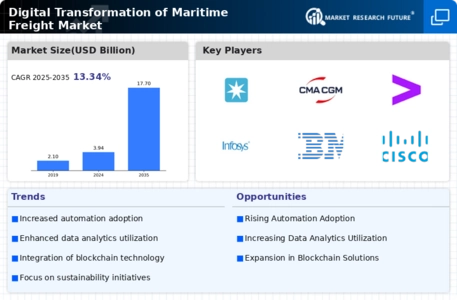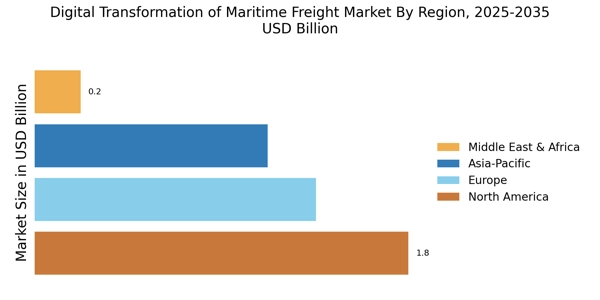Integration of IoT Solutions
The integration of Internet of Things (IoT) solutions is a pivotal driver in the Digital Transformation of Maritime Freight Market. IoT devices facilitate real-time tracking of cargo, enhancing visibility throughout the supply chain. This technology allows stakeholders to monitor conditions such as temperature and humidity, which is particularly crucial for perishable goods. According to recent data, the adoption of IoT in maritime logistics is projected to increase efficiency by up to 30%. This transformation not only reduces operational costs but also improves customer satisfaction by providing accurate delivery timelines. As the industry embraces IoT, it appears that the overall reliability and responsiveness of maritime freight services will significantly improve.
Enhanced Cybersecurity Measures
Enhanced cybersecurity measures are becoming increasingly critical in the Digital Transformation of Maritime Freight Market. As the industry adopts more digital solutions, the risk of cyber threats escalates. Implementing robust cybersecurity protocols is essential to protect sensitive data and maintain operational integrity. Recent reports indicate that cyberattacks on maritime operations have surged, prompting companies to invest heavily in cybersecurity infrastructure. This investment is not merely a defensive strategy; it is also a means to build trust with clients and partners. By ensuring the security of their digital assets, maritime companies can safeguard their reputation and ensure compliance with international regulations, thereby fostering a more resilient industry.
Focus on Supply Chain Resilience
The focus on supply chain resilience is a crucial driver in the Digital Transformation of Maritime Freight Market. Recent disruptions have highlighted the vulnerabilities within traditional supply chains, prompting stakeholders to seek more resilient solutions. By leveraging digital technologies, companies can enhance their ability to respond to unforeseen challenges, such as natural disasters or geopolitical tensions. Data suggests that organizations investing in digital transformation initiatives are better positioned to adapt to market fluctuations. This focus on resilience not only improves operational continuity but also enhances customer trust and satisfaction. As the industry evolves, the emphasis on building robust supply chains will likely remain a priority.
Adoption of Blockchain Technology
Blockchain technology is emerging as a transformative force within the Digital Transformation of Maritime Freight Market. By providing a decentralized ledger, blockchain enhances transparency and security in transactions, which is vital for international shipping. The technology can potentially reduce fraud and errors, streamlining processes such as documentation and payment. Recent estimates suggest that blockchain could save the shipping industry approximately 20 billion dollars annually by minimizing administrative costs. Furthermore, the ability to trace the provenance of goods through blockchain may bolster compliance with regulatory standards, thereby fostering trust among stakeholders. As adoption rates increase, the maritime sector may witness a paradigm shift in operational efficiency.
Emphasis on Automation and Robotics
The emphasis on automation and robotics is reshaping the Digital Transformation of Maritime Freight Market. Automated systems, including autonomous vessels and robotic cargo handling, are being developed to enhance operational efficiency and reduce human error. The market for maritime automation is expected to grow significantly, with projections indicating a compound annual growth rate of over 10% in the coming years. This shift towards automation not only streamlines operations but also addresses labor shortages in the industry. As companies invest in these technologies, they may experience improved turnaround times and reduced operational costs, ultimately leading to a more agile maritime freight sector.


















Leave a Comment